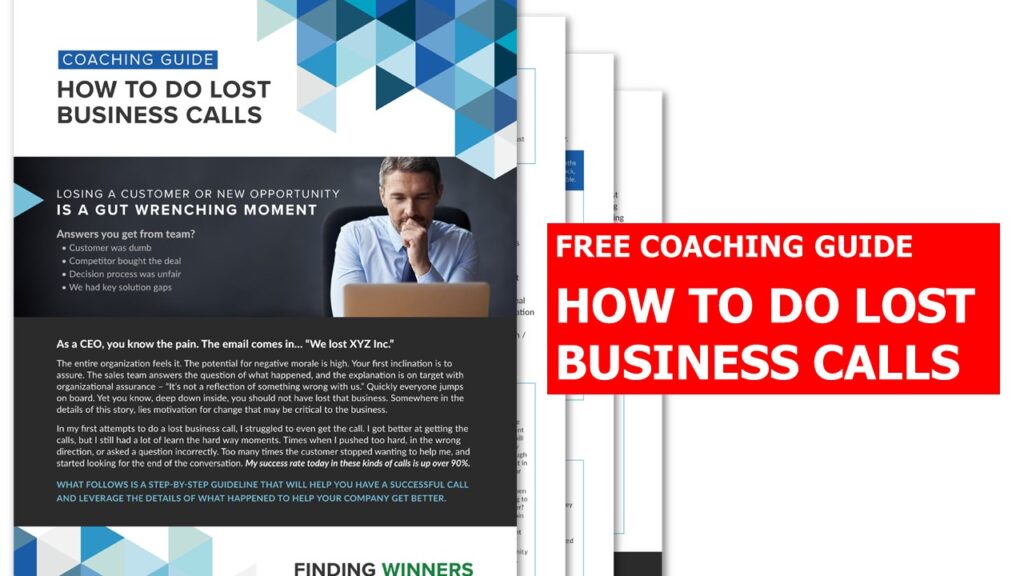
An emerging what happened exploration strategy utilized by CEO’s who go through the gut-wrenching moment of losing a customer or strike zone opportunity, is turning out to be a valuable risk reduction strategy as well in investment or M&A situations. This “look in the rear view mirror” is proving to be instrumental in spotlighting risk and understanding unvalued upside.
Documenting a list of lost customers, lost opportunities and competitive position is a standard part of most due diligence strategies. “Use of Funds” plans that will drive changes in position are often justified with lost opportunity lists. In some cases, an analyst phone call to customer references, current prospects and lost opportunities are used to validate information provided. But these calls are surveys in character and never really uncover what happened on the battlefield.
The reality is many companies are unknowingly off target with messaging, sales methodology, solution and customer engagement strategies. Lost customers and lost opportunities know what these off-target issues are. They know what competitors are doing to take advantage of a weakness. They know why they decided not to move forward with your proposed solution. They have the information you need to set change directions and increase your odds of winning the next one.

Getting someone to share that insight is not going to happen with an analyst or marketing person on the other end of the phone. They won’t even talk to a sales person. Studies show the only person who can get the call and have a chance at quality feedback is the CEO. But CEO’s hate making that call, and often don’t have the customer engagement skills to get maximum information results.
Enter Finding Winners. CEO’s engage us to find out what really happened and suggest change directions. We bring that feedback to their teams and motivate a cross functional effort to change position and keep / win the next customer. CEO’s and investment bankers engage us on the front end of a financing round to line up “Use of Funds” plans with real battlefield moments. Finally, Investors and M&A partners engage us to get a no-spin view of the market, competitors, solution position and customer acquisition capacity.

Private Equity firms often use consultants in a due diligence process. They bring in experts familiar with a market or technology/application. They assess sales methodology, market position, solution position and marketing strategy. But very few of these consultants do Lost Business Assessments. It’s not fun to do. It’s hard to be good at. It’s outside the range of what these consultants can successfully execute. If your goal is due diligence, however, understanding why they lose is a window you want to look through.
Can Private Equity firms develop in house resources to effectively do these calls? Get and review the Coaching Guide to Successful Lost Business Calls. Assess whether you have high relationship skill, customer engagement specialists sitting at your analyst desks that can execute as outlined:
- Can they get the call?
- Can they get you a maximum information dividend?

How many times post investment or merger did things not turn out as expected. The change directions that might have come from a Lost Business Assessment are often right there on the list of – “wish we had known that’s.” Sometimes less than expected results are a mystery. Finding Winners can be engaged to figure out what you have to do to get back on plan. Keep in mind “do nothing” decisions are lost business situations. One of the biggest mysteries in situations where a solution seems to address a significant market need with a solid ROI, is why “the dogs are not eating the dog food.”
Lost Business Assessments turn out to be much more than just a CEO tool to deploy when you need to know what really happened. They also are and should be a standard part of any due diligence process in a B2B business circumstance. Be ready for a less then positive data point. It may be hard information to even share with a target company. It will help you fully understand risk, get to a fair valuation and illuminate unvalued upside tied to direction change.

The next step? Designate an analyst to learn and try to execute the Lost Business Assessment process described in the Coaching Guide. Or put a call into Finding Winners and do a free Situation Review.

